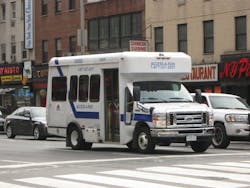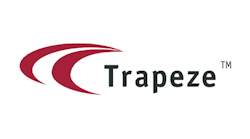The C-Suite Unplugged: What You Have to Do to Provide Excellent Paratransit Service
When MTA Baltimore’s Mobility Services closed out their August reporting they had a whopping 95.49 percent on time performance (OTP) rate, an all-time record for a month at MTA while providing service in the nation’s fifth most congested city.
Additionally, the average P-AFR (preventable accident frequency rate) is about 1 accident per 100,000 miles, again one of the best across the country for an urban area. These two key performance indicators (KPIs) of OTP and P-AFR are generally considered the most important in determining the safety and reliability of paratransit services.
How did Marlon Bates — who served as director of mobility services at the MTA in Baltimore, Maryland for the past year — achieve this feat working with three ADA contractors (Transdev, First Transit and MV) along with non-ADA paratransit service through sedan/taxi services, while still providing between 8-10,000 trips every week day?
Where the Industry Finds Itself
The industry is now at a time where the total per passenger cost to provide ADA service is topping $45 per trip, well over 10 times the cost to provide an individual fixed route bus trip. On average, paratransit makes up about 1-2 percent of system total ridership, but at least 9 percent of operating cost, according to a TCRB report.
Making the scenario even more interesting, paratransit customers have become some of the most vocal advocates of increasing public subsidy and support for transit services and often rely on them for life’s essential mobility. Across the nation, transit systems’ paratransit riders advisory committee meetings are often a lively mix of complaints about individual trip quality and more policy oriented discussions on parameters around providing this service, such as how far into a public building a driver can go to announce his presence for a pickup and “grandfathering” in ADA certified passengers in areas where fixed route service is being eliminated.
Hot Trends
Trends in providing paratransit service now include utilizing shared ride services (such as Lyft) to supplement service. The average cost to an agency of using these providers (as well as traditional taxi services) can often be about half the normal cost. Additionally, many transit systems are now adopting the use of trip broker software, which allows the reservationist to see the projected cost of a trip at booking and choose the provider based on that cost. This can eliminate expensive trips such as individual late night van trips from a traditional contract provider and it can help lower overall costs when used effectively.
Other trends include lowering or eliminating the fare for ADA certified passengers to use fixed route bus/rail service (a much lower cost option) and increasing travel training for regular ADA users so they can adopt fixed route transit usage for their primary mode of mobility.
How to Reach Top Performance in Paratransit Service?
Part of Bates’ success was building on the foundation left by his predecessor, Carl Parr. Parr has a long history with improving paratransit services across the nation for some of the major private contract providers through the use of better systems and technology.
He states there are two principles he lives by in order to provide quality paratransit service:
- Give them the tools to succeed — Parr said, “Nothing bugs me more than a manager telling someone they have to do better when they haven’t provided them the best and proper tools/systems/automation to make it so”
- Individual accountability — He said, “Breaking down each and every person’s job/role into something measurable. Create a matrix by which to measure performance, such as a daily or weekly scorecard. When possible, post the results, encouraging an internal instinct/competition for employees to outperform their peers”
As for Bates, his focus is on the people who provide the service. He says that the system’s high performance was directly the result of his staff’s professionalism, perseverance and teamwork. These attributes on the part of the behind-the-scenes reservationists, schedulers, dispatchers, the safety and maintenance teams, and road supervisors helped make MTA’s paratransit service one of the nation’s safest, most efficient, most reliable, and customer-focused systems.
“We started our journey by… soliciting feedback from stakeholders at all levels (passengers, drivers, dispatchers, mechanics, etc.) to develop a plan that was not only doable but sustainable. We weren’t afraid to ask our providers for their input regarding best practices from around the nation,” Bates said. “We increased the number of subscription trips allowing for better use of the vehicles through grouping. We also made sure our reservations agents were effectively utilizing the trip booking software to more efficiently negotiate trip times.”
As cost and procurement time cutting measures, MTA also recently purchased nearly 150 sedans replacing many of the traditional larger wheelchair lift equipped vans in their fleet. These are used for ambulatory passengers and are much more efficient to operate and maintain.
What You Can Do About it
As paratransit costs escalate, these are some examples of an agency taking innovative approaches to ensure our most vulnerable passengers get the very best service. What methods are you trying to keep costs down but service quality high?

